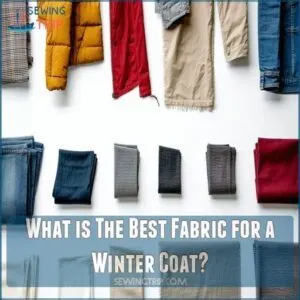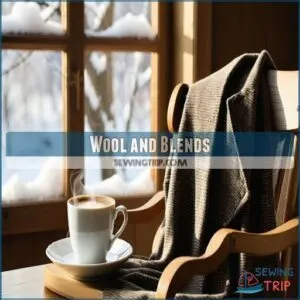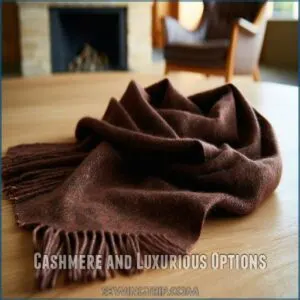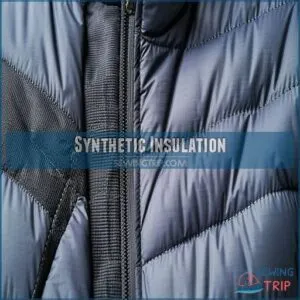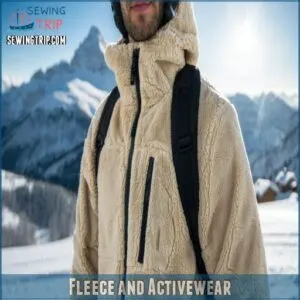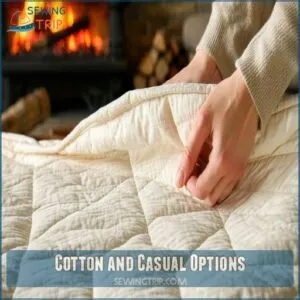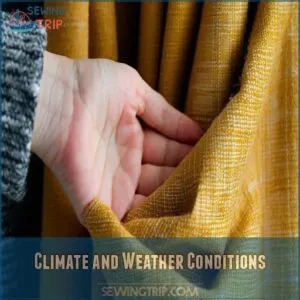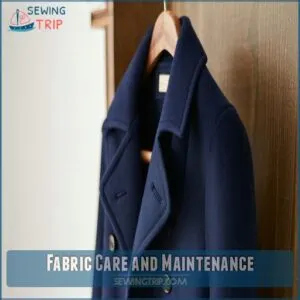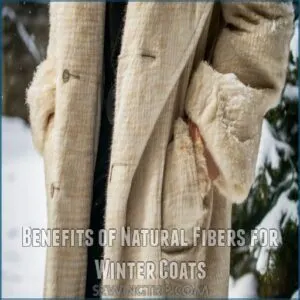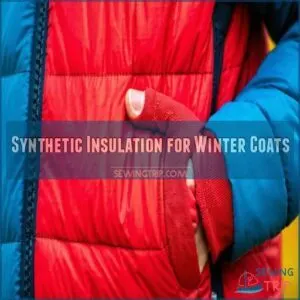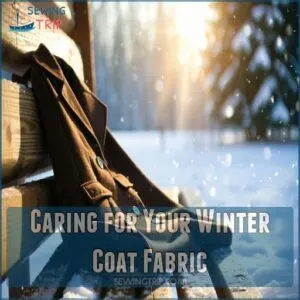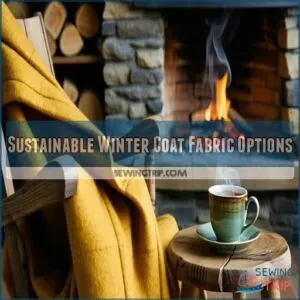This site is supported by our readers. We may earn a commission, at no cost to you, if you purchase through links.
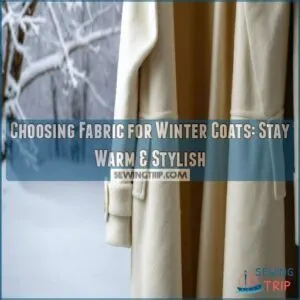
Wool and its blends are classics—you can’t beat their insulation and breathability, ensuring you stay cozy without breaking a sweat.
If you crave luxury, cashmere drapes beautifully and feels like wearing a cloud.
For the eco-warrior in you, consider recycled materials or synthetic insulation like PrimaLoft, which traps warmth well.
Watching out for moisture? Fleece and polyester offer moisture-wicking wonders.
Ultimately, pick a fabric that matches your climate and style preferences, whether you’re combating a blizzard or just embracing winter fashion.
And remember, the right choice whispers elegance.
Table Of Contents
- Key Takeaways
- Choosing The Best Winter Coat Fabric
- What is The Best Fabric for a Winter Coat?
- Types of Winter Coat Fabrics
- How to Select The Right Winter Coat Fabric
- Benefits of Natural Fibers for Winter Coats
- Synthetic Insulation for Winter Coats
- Caring for Your Winter Coat Fabric
- Sustainable Winter Coat Fabric Options
- Frequently Asked Questions (FAQs)
- Conclusion
Key Takeaways
- You should prioritize warmth and breathability when choosing fabrics for your winter coat. Wool and cashmere offer excellent natural insulation, while synthetics like PrimaLoft provide durable, water-resistant warmth.
- Consider your budget and the coat’s intended use. Natural fibers like wool and cashmere are luxurious but more expensive, while synthetics offer affordability and durability. Active lifestyles might benefit from moisture-wicking materials like fleece.
- Pay attention to fabric performance and moisture management. Breathable fabrics prevent overheating and keep you comfortable, while moisture-wicking materials keep you dry. Layering different fabrics can optimize both warmth and comfort.
- Proper care is essential to extend your coat’s life. Always check care labels, address stains promptly, and store your coat properly to prevent damage and maintain its appearance.
Choosing The Best Winter Coat Fabric
When you’re on the hunt for the best winter coat fabric, it’s all about balancing style and warmth.
Whether you’re leaning toward the timeless charm of wool or the high-tech benefits of synthetics, choosing the right material can make all the difference in keeping cozy without sacrificing flair.
Fabrics for Cold Weather
When winter’s chill hits, choosing the right fabric for a cold-weather coat isn’t just about staying warm—it’s an art.
From the weight of your coat material to its eco-friendliness, each choice shapes your winter experience.
Luxurious wool keeps you cozy, while durable fabrics guarantee your coat lasts through many seasons.
Embrace layering techniques: think of it like building a multistory blanket fortress.
Choosing wisely means you won’t just withstand the cold, you’ll embrace it with style and confidence.
Natural Fibers Vs Synthetic
So, you’ve explored fantastic cold-weather fabrics.
Now, let’s weigh natural versus synthetic fibers for your perfect winter coat.
Natural fibers like wool and cashmere offer unmatched comfort and breathability; however, they often come with a higher cost.
Synthetic fibers, on the other hand, boast:
- Superior durability.
- Often better water resistance.
- Lower price points.
Ultimately, the "best" fabric depends on your priorities—comfort, cost, or performance.
Consider what matters most to you!
What is The Best Fabric for a Winter Coat?
When picking the perfect fabric for your winter coat, consider factors like warmth, breathability, and moisture-wicking properties to keep you cozy and stylish all season long.
You wouldn’t want to end up with a coat that feels like wearing a sauna, so choose wisely!
Factors to Consider
Choosing the best fabric for your winter coat often revolves around balancing budget, style, and climate.
Pay attention to warmth: wool or cashmere wraps you in comfort, while synthetic insulation is durable for those stormy days.
Consider what you’ll do; from casual strolls to outdoor adventures, your choice impacts longevity.
Additionally, think about maintenance—some fabrics beg for professional care, others are low-key.
Ultimately, the right coat is your trusty winter companion, blending practicality with personal flair.
Breathability and Moisture-Wicking
Imagine your coat as a breathable fortress against the chill. To balance warmth and comfort, focus on fabric performance and moisture management. Here’s a quick guide:
- Performance Fabrics: Opt for materials with superior breathability and moisture-wicking properties to keep sweat and dampness at bay.
- Layering Strategies: Use breathable layers with natural fibers for thermal insulation and synthetic fibers for added protection.
- Moisture-Wicking: Choose fabrics that draw moisture away from the body, ensuring you stay dry and cozy.
Types of Winter Coat Fabrics
When considering winter coat fabrics, you’ll find a variety of cozy options like wool blends, luxurious cashmere, and practical synthetics to keep you both warm and stylish.
Whether you’re braving the chill in a fleece-lined jacket or feeling elegant in a velvet coat, choosing the right fabric makes all the difference.
Wool and Blends
Wool blends provide warmth and style, making them perfect for winter coats.
Wool blends pair wool with other fabrics to create unique blends that balance warmth, breathability, and durability.
You’re likely familiar with Merino wool, which offers softness along with excellent insulation.
Wool care is straightforward, but remember, it’s naturally sustainable.
Whether battling blizzards or enjoying chilly city strolls, wool fits the bill.
Cashmere and Luxurious Options
When you wrap yourself in cashmere, it’s like a warm hug on a brisk day, providing unparalleled luxury and softness, with a delicate smoothness that caresses the skin gently.
Unlike wool, cashmere offers both elegance and lightweight warmth.
For sustainable cashmere, look for responsible production practices.
Care wisely: gentle washing and proper storage keep your fabulous fabric fresh and cozy, aligning with luxury fabric trends for men and women alike.
Synthetic Insulation
Okay, so you’re all about that cashmere comfort, right? Now, let’s talk synthetic insulation—a fantastic alternative! Think of it as this:
- It’s often cheaper than down.
- It dries super-fast after a snowy adventure.
- Many brands offer eco-friendly choices.
Synthetic insulation provides excellent warmth without breaking the bank or harming the planet.
You’ll find various types, each with its own warmth-to-weight ratio and durability.
Consider your budget and the level of protection you need.
Fleece and Activewear
If you’re out chasing the chill, fleece might just be your best pal.
It offers snug warmth without the heft, perfect for layering.
Unlike its feathery cousin, down, fleece remains cozy even when wet.
You can find a wide variety of winter fleece products to suit your winter needs.
It’s a practical pick for those brisk morning jogs or just curling up with a book, boasting breathability and moisture-wicking magic.
Cotton and Casual Options
Switching gears from fleece’s active vibes, cotton offers a cozy embrace for casual outings.
Picture quilted cotton coats and waxed finishes keeping the chill at bay, blending style with practicality.
Cotton blends provide comfort for everyday use, perfect for winter layering.
So, when casual style meets winter wear, thermal cotton keeps you snug and confident in any setting.
How to Select The Right Winter Coat Fabric
Choosing the right winter coat fabric can make the difference between braving the cold confidently or shivering through the season.
Consider factors like climate, your daily activities, and personal style to make sure your coat is both cozy and chic.
Climate and Weather Conditions
Imagine picking your winter coat fabric like choosing the right flavor for the weather.
Harsh winters need wool or down for excellent winter-proofing.
Milder climates might let you flirt with lighter options.
Pay attention to temperature ranges and precipitation types, ensuring you’re snug against wind chill.
Think of it like dressing for seasonal variations—they’re unpredictable, but you’ve got this!
Intended Use and Activity Level
Choosing the right fabric starts with the intended use and activity level.
Planning a brisk hiking adventure or need everyday wear for chilling commutes?
These choices impact your coat’s performance.
Whether winter sports or casual travel, a good coat matches your needs.
- Winter sports demand breathability.
- Hiking requires durability.
- Workwear benefits from reliable warmth.
Personal Preferences and Style
Embracing personal preferences when picking your winter coat fabric, think about how style reflects your personality.
Whether you’re into bold colors or neutral tones, the fit should offer both warmth and comfort.
Consider length and details—like hoods or pockets—for functionality and flair.
Balancing durability with your unique taste, make sure your choice suits both fashion and those chilly days.
Fabric Care and Maintenance
So, you’ve found your perfect winter coat style. Now, let’s keep it looking its best! Proper fabric care is key. Here’s how:
- Check those care labels – they’re your best friend!
- Address stains ASAP; don’t let them set.
- Store it properly to avoid wrinkles and damage.
Following these simple steps will keep your coat warm and stylish all season long!
Benefits of Natural Fibers for Winter Coats
You’ll find that natural fibers like wool, silk, and cashmere offer warmth, breathability, and elegance for your winter coat.
Embrace the charm of cozy wool, the sleekness of silk, and the plush luxury of cashmere to make your brisk morning walks feel a bit more like a runway show.
Wool and Its Insulating Properties
Wool’s your cozy ally against winter’s cold clutches.
With types like Merino and Icelandic, it locks in warmth while breathing easy.
Wool vs. down? It rivals nicely.
Layer this natural insulator for snug safety.
Regarding wool care, a gentle touch keeps it plush.
Here’s a glimpse:
| Wool Type | Insulation | Breathability | Softness | Durability |
|---|---|---|---|---|
| Merino | High | Excellent | Soft | Durable |
| Icelandic | Superior | Moderate | Medium | Very High |
| Cashmere | Outstanding | Moderate | Ultra-Soft | High |
| Regular Wool | Good | Good | Medium | High |
| Wool Blends | Adjustable | Varies | Varies | Very High |
Silk and Its Breathability
Silk, the unsung hero of winter coat fabric, may not scream "warmth," but it’s brilliant at regulating temperature.
With its breathability and moisture wicking prowess, silk is perfect for layering underneath bulkier fabrics, keeping you comfortable and chic.
Plus, it’s gentle on sensitive skin.
So, whether it’s winter or even summer, silk whispers luxury without shouting.
Cashmere and Its Softness
Imagine wrapping yourself in a cloud—that’s what cashmere feels like.
This fabric is the epitome of softness and warmth.
Its breathability is key to maintaining comfort, as cashmere’s moisture-wicking properties allow it to absorb and release moisture, regulating body temperature.
Easy to care for with some attention, it’s a luxurious choice for winter coats that rival wool in coziness.
- Softness: Unparalleled comfort.
- Warmth: Naturally insulating.
- Style: Timeless elegance.
- Care: Gentle maintenance needed.
Synthetic Insulation for Winter Coats
When choosing a winter coat, synthetic insulation might be your best ally, offering warmth that laughs in the face of wet weather.
With options like PrimaLoft, Thinsulate, and ThermoBall, you can enjoy the cozy embrace of high-tech materials that stay effective even when wet—perfect for staying stylish and practical in unpredictable winter conditions.
PrimaLoft and Thinsulate
Natural fibers like wool offer great warmth, but when you need reliable warmth without the weight, synthetic options like PrimaLoft and Thinsulate shine.
Comparing insulation, PrimaLoft feels like you’re wrapped in a cloud, perfect for cold weather gear.
Thinsulate offers warmth without bulk, keeping you agile.
Both are champions in winter coat performance, providing excellent synthetic insulation for your comfort.
ThermoBall and Other Options
Beyond PrimaLoft and Thinsulate, you’ll find other fantastic synthetic insulation options. ThermoBall, for example, mimics down’s fluffiness, offering impressive warmth.
When choosing the perfect synthetic insulation, consider the fleece warmth ratings to get the right balance of warmth and breathability.
Consider these alternatives:
- 3M Thinsulate.
- Insulite.
- Polartec.
These provide great warmth without breaking the bank, making them budget-friendly choices for your winter coat. They’re also easy to care for—a win-win!
Benefits of Synthetic Insulation
You’re switching from ThermoBall to synthetic insulation, ensuring you get durability, water resistance, and warmth without breaking the bank.
It’s a smart pick if you’ve got kids, a messy pet, or you’re just prone to spills.
Check out the benefits below:
| Benefit | Description | Feeling |
|---|---|---|
| Cost-Effective | Won’t empty your wallet | Relieved |
| Water Resistant | Keeps you dry | Comforted |
| Durable | Built to last | Secure |
Caring for Your Winter Coat Fabric
Caring for your winter coat fabric is easier than wrestling with an uncooperative umbrella during a windstorm.
With these simple tips, you’ll keep your coat looking stylish and luxurious all season long.
Washing and Drying
Slipping out of icy temps doesn’t end with choosing insulation. Fabric care preserves your coat’s warmth.
- Washing Instructions: Always check tags—many fabrics need cold washes to keep from shrinking.
- Drying Methods: Ditch the dryer! Air-dry on a hanger for best results.
- Stain Removal: Blot, don’t rub. A gentle touch maintains waterproofing and durability.
Dry Cleaning and Professional Care
Professional care for your winter coat fabric keeps it luxurious all season.
Consider eco-friendly dry cleaning to reduce environmental impact while ensuring garment longevity.
Got a tricky stain? Leave it to the pros for effective stain removal.
While professional cleaning costs add up, think of it as an investment in fabric longevity.
For dry-cleaning alternatives, always check labels for compatibility.
Storage and Maintenance
Keep your winter coat looking fresh with these storage tips:
- Hang it up: Use sturdy hangers to maintain the coat’s shape.
- Protect from moths: Store in breathable garment bags with cedar blocks.
- Avoid dampness: Keep in a cool, dry place to prevent mold. For delicate materials like cashmere, consider investing in a gentle cashmere coat cleaning product to handle any stains.
- Check regularly: Inspect for wear or pests to make sure it lasts a long time.
Create happy, cozy memories every winter!
Sustainable Winter Coat Fabric Options
When choosing a winter coat, you’ll want to think about eco-friendly materials that combine warmth and sustainability to keep both you and the planet cozy.
With recycled fabrics and responsibly produced textiles, you can stay warm while feeling good about your fashion choices.
Eco-Friendly Materials
Because you care about the planet, consider eco-friendly materials for your winter coat.
Organic cotton feels amazing and is gentle on the earth.
Bamboo fiber is another sustainable choice, super soft and naturally breathable.
Look for coats made with natural fibers like wool from farms practicing ethical sourcing.
These sustainable production methods help protect both people and the environment, creating a stylish and responsible choice.
Recycled and Repurposed Fabrics
Get cozy this winter by choosing recycled and repurposed fabrics for your outfit.
You can also explore online stores offering recycled winter coat options, making it easier to find the perfect eco-friendly material.
These eco-friendly materials, like upcycled textiles from second-hand garments, offer warmth without heavy environmental baggage.
It’s like giving your coat a past life story!
Sustainable fashion doesn’t just keep the chill away; it keeps the planet cozier, too.
You’ll feel snug and stylish.
Responsible Production Practices
After exploring recycled fabrics, let’s tackle how you can embrace ethical sourcing and fair trade in winter coat choices.
Opting for brands that prioritize labor standards and minimize environmental impact, such as those using natural sustainable fabrics, makes sure your coat isn’t just stylish but sustainable.
Look for eco-friendly options and sustainable materials to feel good about your purchase, supporting responsible production practices without sacrificing warmth or style.
Frequently Asked Questions (FAQs)
What is the best fabric for a winter coat?
Did you know that wool retains heat up to 30% better than cotton?
For winter coats, choose wool for its warmth and durability, cashmere for luxury, or down for excellent insulation.
Stay cozy and stylish effortlessly!
Should you buy fabric for winter clothing?
Buying winter fabric is worth it if you’ve got specific styles or quality in mind.
Tailoring your own clothes can mix warmth, class, and durability.
It’s a crafty way to make sure you’re snug and stylish.
Is denim a good fabric for a winter jacket?
Denim’s tough, but it’s not your best bet for a winter jacket.
It’s not very warm, and it’ll let the wind right through.
You’ll want something cozier for those chilly days!
How do I choose a winter coat?
Ironically, the warmth of winter depends more on your coat than a sunny disposition.
Choose one with snug insulation, waterproof features, and durable materials like wool or down.
Prioritize comfort and style to face chilly days confidently.
What fabrics suit for winter?
For winter, choose cozy fabrics like wool, cashmere, and fleece for warmth and comfort.
Silk adds a luxurious thermal layer, while leather provides durable insulation.
Polyester blends and synthetic fleece offer practicality and quick-drying capabilities for outdoor activity.
Is polyester a good winter fabric?
Think polyester isn’t up to par?
It’s your winter MVP — quick-drying, durable, and surprisingly warm.
Perfect for staying cozy on chilly days, this fabric’s reliability might just win you over with its stylish versatility!
What is the best fabric for a winter coat?
The best fabric for a winter coat balances warmth and style.
Opt for wool for classic warmth, cashmere for luxury, down for insulation, or synthetic materials like Thinsulate for practicality.
Each offers unique benefits to suit your needs.
Which material would make the warmest winter coat?
Cashmere makes the warmest winter coat, offering unmatched warmth and luxurious comfort.
It feels like wearing a snug, elegant hug.
Although pricey, its softness, insulation, and breathability make it a top choice for warmth seekers.
When making a winter coat, you should pick a fabric that is?
Did you know wool retains 80% of its insulating powers even wet?
When making a winter coat, choose materials like wool or down for warmth, or opt for water-resistant synthetics for a stylish, durable shield against cold.
What is the fabric used to make winter coats?
Winter coats use various fabrics!
You’ll find wool for warmth, down for lightweight insulation, synthetic materials for water resistance, and even fleece for cozy comfort.
It’s all about your style and needs!
How do I layer fabrics effectively?
Layering fabrics is like building a cozy nest.
Start with a silk or merino wool base, add warmth with fleece or cashmere mid-layers, and finish with a stylish outer shell.
Mix textures to keep things comfy and chic.
Which fabrics are best for windy climates?
When it’s blowing like the wind and needing warmth, layers from wool, especially cashmere, offer unmatched protection.
Pair with a Gore-Tex shell for windproofing.
Add a touch of flannel for style and warmth.
How to waterproof a fabric coat?
To waterproof a fabric coat, spray it with a waterproofing treatment like Scotchgard or Nikwax.
Pay careful attention to seams and areas prone to moisture.
Make sure the coat is clean before application for the best results.
What is the warmest coat lining material?
Cashmere lining is like wrapping yourself in a warm hug from an oversized teddy bear, offering unmatched softness and insulation.
It’s luxurious, divine, and perfect for those chilly days, balancing style with cozy warmth effortlessly.
How to spot quality fabric in stores?
Feel for weight and softness—lighter fabrics often skip on quality.
Check stitching for tightness, giving a tug to test durability.
Look for natural fibers like wool or cashmere, which drape fluidly and retain warmth luxuriously.
Conclusion
Picture yourself enveloped in a coat that feels as cozy as a favorite blanket.
Choosing fabric for winter coats means balancing warmth, style, and practicality.
From wool’s classic appeal to cashmere’s luxurious touch, you’ve got options aplenty.
Consider what suits your climate, lifestyle, and taste.
Whether you opt for eco-friendly choices or high-performance synthetics, you’ll stay warm and stylish.
Remember, a well-chosen coat fights the cold but also whispers your personal style statement.


